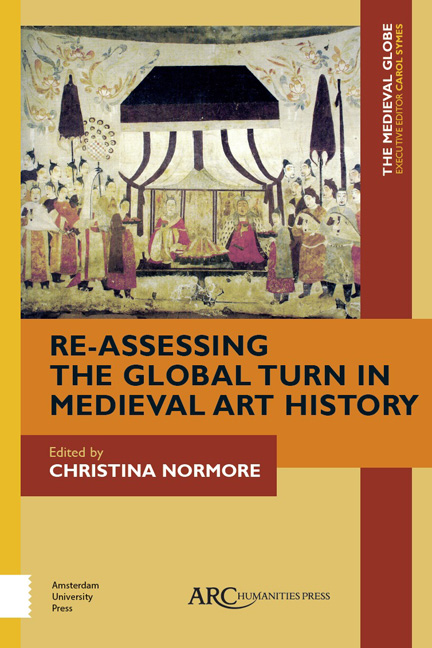Book contents
- Frontmatter
- Contents
- List of Illustrations
- Editor’s Introduction: A World within Worlds? Reassessing the Global Turn in Medieval Art History
- A Camel’s Pace: A Cautionary Global
- The Fatimid Holy City: Rebuilding Jerusalem in the Eleventh Century
- Worldliness in Byzantium and Beyond: Reassessing the Visual Networks of Barlaam and Ioasaph
- Exchange of Sacrifices: West Africa in the Medieval World of Goods
- The Beryozovo Cup: A Byzantine Object at the Crossroads of TwelfthCentury Eurasia
- Mobile Meanings: A Global Approach to a Dagger from Greater Syria
- Global Medieval at the “End of the Silk Road,” circa 756 CE: The Shōsō-in Collection in Japan
- Response: Medievalists and Early Modernists—A World Divided?
- Index
Response: Medievalists and Early Modernists—A World Divided?
Published online by Cambridge University Press: 23 January 2021
- Frontmatter
- Contents
- List of Illustrations
- Editor’s Introduction: A World within Worlds? Reassessing the Global Turn in Medieval Art History
- A Camel’s Pace: A Cautionary Global
- The Fatimid Holy City: Rebuilding Jerusalem in the Eleventh Century
- Worldliness in Byzantium and Beyond: Reassessing the Visual Networks of Barlaam and Ioasaph
- Exchange of Sacrifices: West Africa in the Medieval World of Goods
- The Beryozovo Cup: A Byzantine Object at the Crossroads of TwelfthCentury Eurasia
- Mobile Meanings: A Global Approach to a Dagger from Greater Syria
- Global Medieval at the “End of the Silk Road,” circa 756 CE: The Shōsō-in Collection in Japan
- Response: Medievalists and Early Modernists—A World Divided?
- Index
Summary
AS SPECIALISTS IN early modern European art, the articles in this collection in The Medieval Globe fascinate us with new approaches to objects, teach us about zones of cultural interactions that are little known outside specialist circles, and invite us to consider some of the themes they share and the larger questions they raise about current trends in premodern art historical scholarship. The essays collected here draw on artifacts dating from the fifth to the fifteenth centuries which circulated around Africa, Asia, and Europe. As such, they provide an expanded view of medieval art history beyond its traditional European focus, and enrich earlier interpretations of artworks as diverse as ivory sculpture, illuminated manuscripts, ceremonial vessels, and weaponry. As a whole, this collection of essays makes clear the ways in which current medieval and early modern histories of art are considering similar issues from multiple and, at times, compatible points of view. Both fields share an interest in the relationship between the local and the global, the complexities of identity, and the methodological challenges posed by considering objects within a global network. At the same time, reading these pieces has reminded us of some crucial differences between the global medieval world and the global early modern world, and they have thrown into relief the diversity of art historical concerns on both sides of the period divide, however artificial that divide may seem.
The Importance of the Local
One of the most prominent themes of this volume is the emphasis on the diversity of local adaptations and interpretations of objects and texts that were shuttled across remarkable distances and terrain, traversing (modern) political, social, religious, and linguistic borders. In each case, exegetical strategies were mobilized to signal either local religious or political ideology. For example, Cecily Hilsdale takes up Byzantine monastic iterations of the tales of Barlaam and Ioasaph —a narrative that emerged in Buddhist India and that moved through the Byzantine Empire to the Latin West over the course of the tenth, eleventh, and twelfth centuries. Hilsdale makes clear that translations of Barlaam and Ioasaph in monastic contexts stressed the ascetic dimensions of the narrative, while at the same time ascetic monastic centres created textual objects that would have been valued, in part, for their sumptuous illuminations.
- Type
- Chapter
- Information
- Re-Assessing the Global Turn in Medieval Art History , pp. 203 - 218Publisher: Amsterdam University PressPrint publication year: 2018



